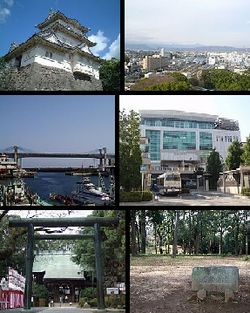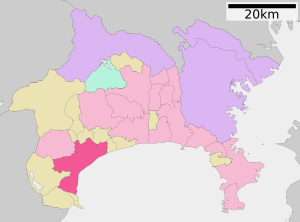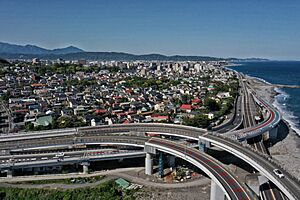Odawara facts for kids
Quick facts for kids
Odawara
小田原市
|
|||||||||||||||
|---|---|---|---|---|---|---|---|---|---|---|---|---|---|---|---|

Top left: Odawara Castle, Top right: Panorama view of Odawara, from Odawara Castle Park, Middle left: Odawara Fishing Port, Middle right: Odawara Station, Bottom left: Sontoku Ninomiya Shrine, Bottom right: Ishigakiyama Castle Park
|
|||||||||||||||
|
|||||||||||||||
 |
|||||||||||||||
| Country | Japan | ||||||||||||||
| Region | Kantō | ||||||||||||||
| Prefecture | Kanagawa | ||||||||||||||
| Area | |||||||||||||||
| • Total | 113.79 km2 (43.93 sq mi) | ||||||||||||||
| Population
(June 1, 2021)
|
|||||||||||||||
| • Total | 188,482 | ||||||||||||||
| • Density | 1,656.40/km2 (4,290.06/sq mi) | ||||||||||||||
| Time zone | UTC+9 (Japan Standard Time) | ||||||||||||||
| Phone number | 0465-33-1302 | ||||||||||||||
| Address | 300 Ogikubo, Odawara-shi, Kanagawa-ken 250-8555 | ||||||||||||||
| Climate | Cfa | ||||||||||||||
|
|||||||||||||||
Odawara (小田原市, Odawara-shi) is a city in Kanagawa Prefecture, Japan. As of June 2021, about 188,482 people live there. The city covers an area of 113.79 square kilometers.
Contents
Geography of Odawara
Odawara is located in the western part of Kanagawa Prefecture. It sits on the Ashigara Plains, at the southwestern tip of the Kantō region. The city is surrounded by the Hakone Mountains to the north and west. To the east is the Sakawa River, and to the south is Sagami Bay of the Pacific Ocean.
Neighboring Towns and Cities
Odawara shares borders with several other places in Kanagawa Prefecture:
- Hakone
- Kaisei
- Manazuru
- Minamiashigara
- Nakai
- Ninomiya
- Ōi
- Yugawara
Odawara's Climate
Odawara has a humid subtropical climate. This means it has warm summers and cool winters. There is usually little to no snowfall. The average temperature each year is about 13.4°C. September is the wettest month, with an average of 2,144 mm of rain per year. August is the warmest month, averaging around 24.2°C. January is the coldest, with temperatures around 2.9°C.
Population Trends in Odawara
Based on Japanese census data, the number of people living in Odawara grew until around the year 2000. Since then, the population has slightly decreased.
| Historical population | ||
|---|---|---|
| Year | Pop. | ±% |
| 1960 | 131,366 | — |
| 1970 | 163,631 | +24.6% |
| 1980 | 177,467 | +8.5% |
| 1990 | 193,417 | +9.0% |
| 2000 | 200,173 | +3.5% |
| 2010 | 198,327 | −0.9% |
| 2020 | 188,856 | −4.8% |
History of Odawara
The area where Odawara is today has been lived in since ancient times. Evidence shows that many people lived here during the Jōmon period. Later, in the Nara period, it became part of Ashigarashimo District. During the Heian period, the land was divided into large estates. These were mostly controlled by the Hatano clan.
Battles and Castles
A famous battle, the Battle of Ishibashiyama, happened near Odawara during the Genpei War. This war was fought between the Heike clan and Minamoto no Yoritomo. In the Sengoku period, Odawara grew into an important castle town. It became the capital of the later Hōjō clan, who ruled most of the Kantō region.
Even though Odawara Castle was thought to be impossible to capture, the Hōjō clan was defeated. This happened during the Battle of Odawara in 1590 by Toyotomi Hideyoshi. After this, Tokugawa Ieyasu took control of the area. Under the Tokugawa shogunate, Odawara was the center of Odawara Domain. This was a feudal area ruled by different daimyō (powerful Japanese lords). The town also became a busy post station called Odawara-juku. It was on the Tōkaidō highway, which connected Edo (now Tokyo) with Kyoto.
Modern Challenges and Growth
After the Meiji Restoration, Odawara briefly became its own prefecture. Then it joined Kanagawa Prefecture in 1876. During this time, the main center for business and politics in Kanagawa moved to Yokohama. Odawara's population dropped a lot. It got even worse when the main Tōkaidō Main Line railway bypassed the city.
In 1923, a huge earthquake, the Great Kantō earthquake, hit the region. Its center was deep under Izu Ōshima Island. This earthquake caused massive damage in Tokyo, Yokohama, and nearby prefectures. Ninety percent of buildings in Odawara collapsed, and fires destroyed what was left.
Odawara started to recover when the Tanna Tunnel opened in 1934. This brought the main Tōkaidō Main Line railway through the city. Odawara officially became a city on December 20, 1940. On August 15, 1945, Odawara was the last city in Japan to be bombed by Allied planes during World War II. On November 1, 2000, Odawara's population went over 200,000. It was then named a special city, which gave it more local control.
Economy of Odawara
Odawara is an important business hub for western Kanagawa Prefecture. It has light industries, chemical companies, and food processing plants. Farming and commercial fishing are smaller parts of the local economy. Many people who live in Odawara also travel to work in Yokohama and Tokyo.
Education in Odawara
Odawara has many schools for young people. The city government runs 25 public elementary schools and 12 public middle schools. The Kanagawa Prefectural Board of Education operates four public high schools. There is also a special education school for students with disabilities.
In addition to public schools, Odawara has one private elementary school, one private middle school, and two private high schools. There is also a private junior college called the Odawara Women's Junior College.
Transportation in Odawara
Odawara is a key transportation hub. Many railway lines and highways pass through or start here.
Railway Lines
 JR Tōkai - Tōkaidō Shinkansen (bullet train)
JR Tōkai - Tōkaidō Shinkansen (bullet train)
- Odawara
 JR Tōkai - Gotemba Line
JR Tōkai - Gotemba Line
- Shimo-Soga - Kōzu
 JR East - Tōkaidō Main Line
JR East - Tōkaidō Main Line
- Kōzu - Kamonomiya - Odawara - Hayakawa - Nebukawa
 Odakyu Electric Railway – Odakyu Odawara Line
Odakyu Electric Railway – Odakyu Odawara Line
- Kayama - Tomizu - Hotaruda - Ashigara - Odawara
 Izuhakone Railway - Daiyūzan Line
Izuhakone Railway - Daiyūzan Line
- Odawara - Midorichō - Isaida - Gohyakurakan - Anabe - Iidaoka - Sagami-Numata
 Hakone Tozan Railway - Hakone Tozan Line
Hakone Tozan Railway - Hakone Tozan Line
- Odawara - Hakone-Itabashi - Kazamatsuri - Iriuda
Major Highways
 Odawara-Atsugi Road (Odawara-Atsugi Road)
Odawara-Atsugi Road (Odawara-Atsugi Road) National Route 1, connecting to Tokyo or Kyoto
National Route 1, connecting to Tokyo or Kyoto National Route 135, connecting to Shimoda
National Route 135, connecting to Shimoda National Route 138, connecting to Fujiyoshida
National Route 138, connecting to Fujiyoshida National Route 255, connecting to Hadano
National Route 255, connecting to Hadano National Route 271, connecting to Atsugi (a toll road)
National Route 271, connecting to Atsugi (a toll road)
Bus Services
Bus services are also available, including routes to the Izu Peninsula.
Fun Things to See and Do in Odawara
Odawara is a great place to visit, especially for its famous Odawara Castle. It's also a main starting point for trips to the Hakone hot springs resort area. This area is part of the beautiful Fuji-Hakone-Izu National Park. Inside Odawara city, the Yugawara area is also a well-known hot spring resort.
Historical Sites
Besides Odawara Castle, another important historical site is Ishigakiyama Ichiya Castle. This castle was built by Toyotomi Hideyoshi.
Nature and Sea Life
Enoura is a coastal part of Odawara known for its very clean sea. You can find many kumamomi fish there, which like clear water. Sometimes, even Sea turtles can be seen. Because the water is so clear and there's lots of sea life, many people come to Enoura for scuba diving.
Local Specialties
Odawara is famous for its traditional foods. These include kamaboko (processed fish cakes), stockfish, and umeboshi (salted plums). The city is also known for its traditional herbal medicines. You can visit the Suzuhiro Kamaboko Village to learn how kamaboko is made and even try making it yourself!
Festivals and Events
The Odawara Hōjō Godai Festival is the city's biggest tourism event. It happens every year on May 3 during Golden Week. It's a lively celebration of the city's history.
Sister Cities
Odawara has special relationships with other cities around the world:
 Nikkō, Tochigi, Japan (since December 19, 1980)
Nikkō, Tochigi, Japan (since December 19, 1980) Kishiwada, Osaka, Japan (since June 26, 1968)
Kishiwada, Osaka, Japan (since June 26, 1968) Chula Vista, California, United States (since November 8, 1981)
Chula Vista, California, United States (since November 8, 1981) Manly, New South Wales, Australia (a friendship city, since 1991)
Manly, New South Wales, Australia (a friendship city, since 1991) Shenzhen, Guangdong, China (since February 4, 1993)
Shenzhen, Guangdong, China (since February 4, 1993)
Famous People from Odawara
Many notable people have come from Odawara, including:
- Kai Atō, an actor
- Akira Hagiwara, a racing driver
- Yōhei Kōno, a politician
- Rumina Sato, a mixed martial arts fighter
- Ninomiya Sontoku, an economist and philosopher from the Edo period
- Shogo Suzuki, an actor and musician
- Kitamura Tokoku, an author
- Yoshiyuki Tomino, an anime movie director, known for Gundam
- Baku Yumemakura, a science fiction author
See also
 In Spanish: Odawara para niños
In Spanish: Odawara para niños







